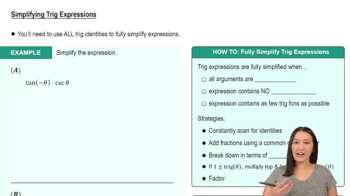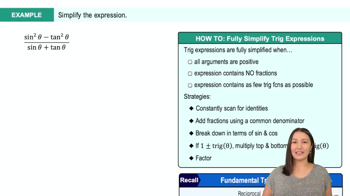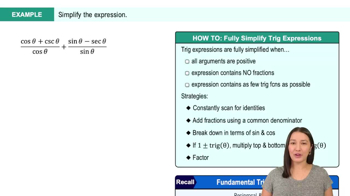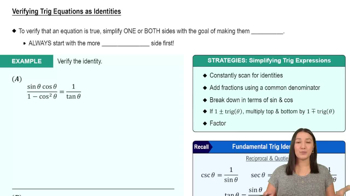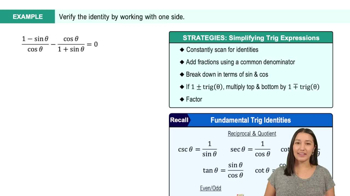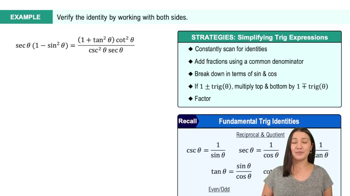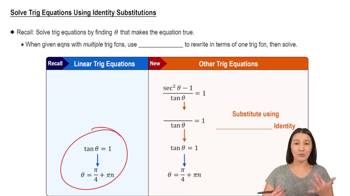Table of contents
- 0. Functions7h 52m
- Introduction to Functions16m
- Piecewise Functions10m
- Properties of Functions9m
- Common Functions1h 8m
- Transformations5m
- Combining Functions27m
- Exponent rules32m
- Exponential Functions28m
- Logarithmic Functions24m
- Properties of Logarithms34m
- Exponential & Logarithmic Equations35m
- Introduction to Trigonometric Functions38m
- Graphs of Trigonometric Functions44m
- Trigonometric Identities47m
- Inverse Trigonometric Functions48m
- 1. Limits and Continuity2h 2m
- 2. Intro to Derivatives1h 33m
- 3. Techniques of Differentiation3h 18m
- 4. Applications of Derivatives2h 38m
- 5. Graphical Applications of Derivatives6h 2m
- 6. Derivatives of Inverse, Exponential, & Logarithmic Functions2h 37m
- 7. Antiderivatives & Indefinite Integrals1h 26m
0. Functions
Trigonometric Identities
Problem 86
Textbook Question
Prove the following identities.
1+cosθsinθ=sinθ1−cosθ
 Verified step by step guidance
Verified step by step guidance1
Start by examining the left-hand side of the identity: \( \frac{\sin\theta}{1+\cos\theta} \).
Multiply both the numerator and the denominator of the left-hand side by the conjugate of the denominator, which is \( 1-\cos\theta \). This gives: \( \frac{\sin\theta (1-\cos\theta)}{(1+\cos\theta)(1-\cos\theta)} \).
Simplify the denominator using the difference of squares formula: \((1+\cos\theta)(1-\cos\theta) = 1 - \cos^2\theta\).
Recognize that \(1 - \cos^2\theta\) is equal to \(\sin^2\theta\) by the Pythagorean identity.
Simplify the expression: \( \frac{\sin\theta (1-\cos\theta)}{\sin^2\theta} = \frac{1-\cos\theta}{\sin\theta} \), which matches the right-hand side of the identity.
Recommended similar problem, with video answer:
 Verified Solution
Verified SolutionThis video solution was recommended by our tutors as helpful for the problem above
Was this helpful?

 6:36m
6:36mWatch next
Master Simplifying Trig Expressions with a bite sized video explanation from Callie
Start learningRelated Videos
Related Practice

